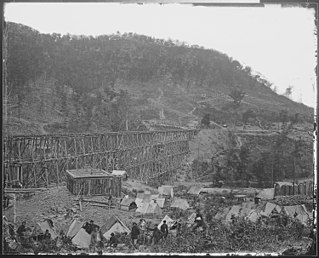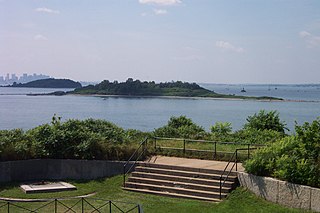Service
Attached to Army of the West and Unattached District of Southwest Missouri, Dept. of Missouri, to September, 1862. Fremont's Campaign against Springfield, Mo., September to November, 1861. Duty at Jefferson City, Rolla and Springfield, Mo., until December 29, 1861. Advance to Springfield, Mo., and the Southwest December 29, 1861, to February 14, 1862. Duty in District of Southwest Missouri until September, 1862.
On March 8, 1862, Special Orders No. 43 of the Adjutant General of Missouri ordered Gerster's Independent Company of Pioneers consolidated with other units to form the 5th Missouri Volunteer Infantry. [1]
On December 18, 1862, Captain Gerster's company, now known as Company "H", 5th Missouri Volunteer Infantry, was reassigned, becoming Company "H", 27th Missouri Volunteer Infantry. [2] The history of Gerster's company merges with the 27th Missouri from this point.
The members of the company remaining in the 27th Missouri Volunteer Infantry were mustered out on May 15, 1865. [3]

The 5th New York Infantry Regiment, also known as Duryée's Zouaves, was a volunteer infantry regiment that served in the U.S. Army during the American Civil War. Modeled, like other Union and Confederate infantry regiments, on the French Zouaves of Crimean War fame, its tactics and uniforms were different from those of the standard infantry.
The 12th Wisconsin Infantry Regiment was an infantry regiment that served in the Union Army during the American Civil War. They served primarily in the western theatre, participating in battles and campaigns including the Siege of Vicksburg, the Jackson expedition, and Sherman's March to the Sea.
The 2nd Wisconsin Cavalry Regiment was a volunteer cavalry regiment that served in the Union Army in the western theater of the American Civil War.

The 13th Regiment Illinois Volunteer Infantry, nicknamed "Fremont's Grey Hounds," was an infantry regiment that served in the Union Army during the American Civil War. The Thirteenth was one of the regiments organized under the act known as the Ten Regiment Bill.

The 10th Illinois Infantry Regiment was an infantry regiment that served in the Union Army between April 20, 1861, and July 11, 1865, during the American Civil War.
The 21st Regiment Illinois Volunteer Infantry was a volunteer infantry regiment that served in the Union Army during the American Civil War.
The 25th Regiment, Illinois Volunteer Infantry, was an infantry regiment that served in the Union Army during the American Civil War.
The 26th Regiment Illinois Volunteer Infantry was an infantry regiment that served in the Union Army during the American Civil War.
The 37th Regiment Illinois Volunteer Infantry, nicknamed the "Fremont Rifles" and "Illinois Greyhounds", was an infantry regiment that served in the Union Army during the American Civil War.

The 42nd Regiment Illinois Volunteer Infantry was an infantry regiment that served in the Union Army during the American Civil War. It is one of the 300 fighting regiments.

The 59th Illinois Infantry Regiment was an infantry regiment that served in the Union Army during the American Civil War. It was formed as the 9th Missouri Infantry Regiment in September 1861, and changed name to the 59th Illinois Infantry Regiment in February 1862.
The Missouri State Militia was a federally funded state militia organization of Missouri conceived in 1861 and beginning service in 1862 during the American Civil War. It was a full-time force whose primary purpose was to conduct offensive operations against Confederate guerrillas and recruiters as well as oppose raids by regular Confederate forces. The militia at one time numbered more than 13,000 soldiers, but this force was reduced to 10,000 soldiers, by the United States government.

The Unattached Companies of Massachusetts Volunteer Militia were units of infantry raised for the defenses of the eastern coast of Massachusetts during the American Civil War. Twenty-six companies were mustered into the Union Army during 1864-1865, several of them reorganizing for additional terms of service.
The 2nd Missouri Infantry Regiment was an infantry regiment, formed from a voluntary regiment using the same name, that served in the Union Army during the American Civil War.

The 51st Regiment Massachusetts Volunteer Infantry was a regiment of infantry that served in the Union Army during the American Civil War. The regiment was assigned to Major General John G. Foster's Department of North Carolina, later designated as the XVIII Corps. While based in New Bern, North Carolina, the 51st Massachusetts took part in several expeditions involving numerous units from Foster's command and were engaged in the Battle of Kinston, the Battle of White Hall and the Battle of Goldsborough Bridge, among other engagements.
The 10th Missouri Infantry Regiment was an infantry regiment that served in the Union Army during the American Civil War.
The 5th Missouri Infantry Regiment was an infantry regiment that served in the Union Army during the American Civil War.
The Voerster's Independent Company of Sappers and Miners was an independent company of military engineers that served in the Union Army during the American Civil War.

Battery F, 1st Missouri Light Artillery Regiment was an artillery battery unit from Missouri that served in the Union Army during the American Civil War. The battery participated in operations in December 1861. Battery F fought at the battles of Prairie Grove and Van Buren in December 1862. The battery fought at Vicksburg, Brownsville, Mustang Island, and Fort Esperanza in 1863. The unit fought at Spanish Fort, and Fort Blakely in 1865. Battery F was mustered out on 11 August 1865.

1st Missouri Light Artillery Regiment was a artillery unit from Missouri that served in the Union Army during the American Civil War. The unit began its service as the 1st Missouri Infantry Regiment, but converted to an artillery regiment in September 1861 and was brought up to a strength of 12 companies. Thereafter, each company served as an individual artillery battery, often separated from the other companies in the regiment. The individual batteries served in many actions in the Western Theater of the American Civil War and several batteries served together at key battles such as Fort Donelson, Shiloh, Corinth, Prairie Grove, and Vicksburg.
 This article contains text from a text now in the public domain : Dyer, Frederick H. (1908). A Compendium of the War of the Rebellion. Des Moines, IA: Dyer Publishing Co.
This article contains text from a text now in the public domain : Dyer, Frederick H. (1908). A Compendium of the War of the Rebellion. Des Moines, IA: Dyer Publishing Co. 







